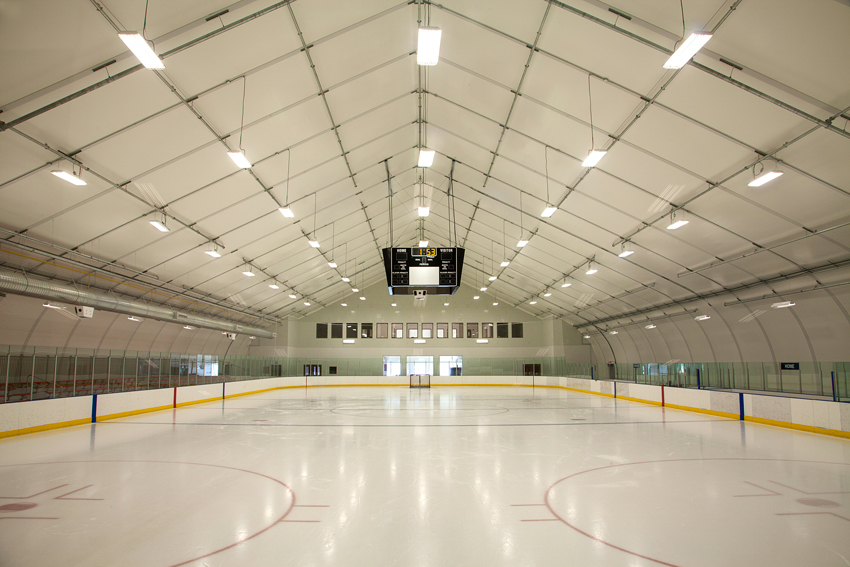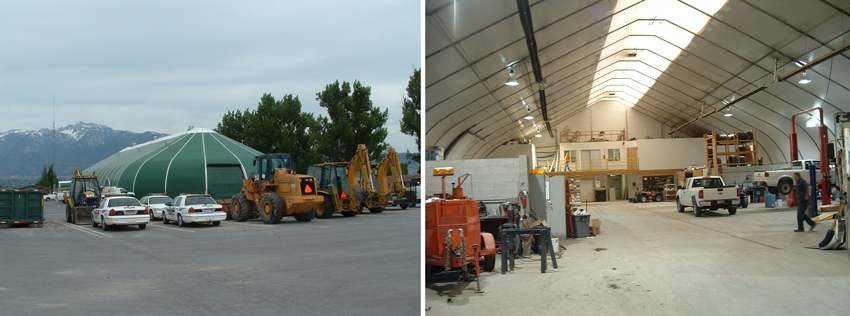Revolutionary, Permanent Tensioned Membrane Aluminum Frame Supported Structures
Performance Standards: Analyzing Code Compliance
Engineered tensioned membrane structures have several components. Modular, vaulted frames are assembled as a system braced by intermediary members. The materials and their environmental benefits that comprise these systems include bolted aluminum frames, architectural coated interior and exterior membranes, optional formaldehyde-free insulation packages and skylights, and window and door systems.
As with more conventional modular systems, when selecting a tensioned membrane aluminum frame supported structure, the design professional is required to make more decisions at earlier stages in the project. Communication between the design team, the owner, the manufacturers, mechanical and electrical engineers as well as the contractor and manufacturer’s technicians are critical components of a successful project. The professional armed with certifications of code compliance to strict energy, structural, fire-safety, and occupancy requirements will ease the path to planning and building department approvals. The International Building Code (IBC) include the following definitions to describe membrane supported aluminum frame supported structures:
- A membrane-covered frame structure is defined in the International Building Code (IBC) in Chapter 2: Definitions as a “non-pressurized building wherein the structure is composed of a rigid framework to support a tensioned membrane which provides the weather barrier.”
- Membrane structures are addressed in Chapter 31, Section 3101. Section 3102.1: General states: “The provisions of Sections 3102.1 through 3102.8 shall apply to air-supported, air-inflated, membrane-covered cable and membrane-covered frame structures, collectively known as membrane structures, erected for a period of 180 days or longer. Those erected for a shorter period of time shall comply with the current International Fire Code.”
- The type of construction for membrane structures in defined in Section 3102. They can either be defined as Type IIB or Type V construction. The code states: “…Noncombustible frame or cable-supported structures covered by an approved membrane in accordance with Section 3102.3.1 shall be classified as Type II B construction…Other membrane structures shall be classified as Type V construction.”
- The membrane portion of the structure is to be designed as per the ASCE Standard 55: Tensile Membrane Structures, which states, “This standard provides minimum criteria for the analysis, design, and performance of membrane-covered cable and rigid member structures, collectively known as tensile membrane structures, including permanent and temporary structures…The requirements of this standard shall apply whether the tensile membrane structure is independent of or attached to another structure.”
The code does not restrict the use of this structure to temporary installations. As long as the assembly meets code requirements, these structures can last as long as traditional building systems. Along with the codes that define membranes, the other key areas to consider are the supporting aluminum structure and necessary fire-code requirements.

Photo courtesy of Sprung Structures, Inc.
Lightweight aluminum frames allow for large clear-span buildings as demonstrated in the Central Park Arena building in Collingwood, Ontario.
Lightweight Aluminum Frames
The code is specific regarding the aluminum frames. Lightweight aluminum frames provide numerous advantages when used in buildings. Aluminum is recyclable and can be selected with a high content of recycled materials. The use of aluminum in construction allows for easy assembly of components using lighter equipment such as cranes, delivery systems, and crew handling.
The assembly of frames begins with the delivery of premanufactured, engineered aluminum frames. These frames are placed on the site in well-marked pieces in order of assembly. Assembled in place, the frames are hoisted into space and secured to the appropriate foundation. After a review of the structural loading of the building as well as an analysis of soil conditions, an engineer may select an earth anchor as an alternative to a traditional foundation. The lightness of the aluminum frame and membrane building skin contribute to the equation that allow the engineer to select earth anchors instead of concrete footings, which allows these structures to be built on existing parking lots. Commonly used in geotechnical or construction of tents and sports arenas, earth anchors are devices that are engineered for use both in temporary or permanent applications.

Image courtesy of Sprung Structures, Inc.
This rendering shows earth-anchoring systems for tensioned membrane aluminum frame supported structures.
These aluminum frame supported structures can meet the requirements of Section 507 of the IBC, Unlimited Area Buildings. Structures can be set back accordingly and sprinkler systems can be installed. Chapter 20 of the IBC, section 2002 does allow for aluminum to be an acceptable structural building material.
The large structural aluminum frames are designed to support the weight of the structure and any additional utility or equipment loads as well as wind and snow loads. This type of building can be engineered to meet even the most stringent hurricane loading conditions. After the frame is erected, an exterior membrane is winched into place between the frames, then tensioned with a 10-ton hydraulic jack and ram. This provides an exterior skin for the building. Electrical and mechanical systems are placed in the frame along with an extensive network of accessible power requirements and ventilation systems that maximized flexibility for future equipment modifications.
An interior membrane is winched into the frame. This membrane can be insulated and provides the finished surface of the interior. Mechanical and electrical access panels are placed along the interior walls. Skylights, doors, windows, transparent panels enclose the finish structure. Attachments to the structure of mechanical systems, sprinklers, lighting, and heavier equipment is engineered into the structure using direct connections to the bottom flange of the beams reviewed on a case-by-case basis.
The IBC Chapter 20, Section 2002: Materials allows the use of aluminum for structural materials. The Aluminum Association’s Aluminum Design Manual 1 (ADM1), Chapter 35, references Part 1-A: Specification for Aluminum Structures, Allowable Stress Design and Part 1-B: Aluminum Structures, Load and Resistance Factor Design (1604.3.5, 2002.1). Structures are to be designed using the minimum load requirements as referenced in Chapter 16 using accepted engineering practices.
Aluminum is durable, lightweight, long lasting, and one of the most recycled metal products in today’s market. Aluminum frames used as the skeletal spine are as easy to mount into place as well, as they are easily demountable to be reused. Connections are fitted and bolted rather than welded, as would be typical in a steel substructure. The structural system is engineered to withstand high wind loads and shed snow. These substructures are 100 percent recyclable with no loss of quality when reused in another product.












